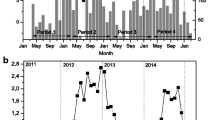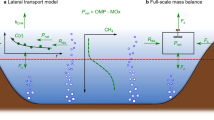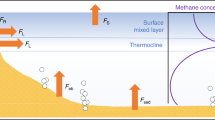Abstract
We measured methane concentrations in the surface water of the northern basin of Lake Lugano in spring (May 2012) and autumn (October 2011, 2012), and calculated turbulent diffusive methane fluxes to the atmosphere. Surface water methane concentrations were highly variable in space and time but always exceeded atmospheric equilibrium. Methane concentrations were significantly lower in spring (on average 16 nmol L−1) than during the autumn sampling campaigns (on average 57 nmol L−1 in 2011 and 45 nmol L−1 in 2012). This suggests methane accumulation in the surface mixed layer during the summer productive season. The origin of the methane in the lake’s surface waters requires further assessment, but the observed concentration profiles indicate that the excess methane originates from a near-surface source, rather than from the large deep-water methane pool in the anoxic monimolimnion. As a consequence of the higher surface water methane concentrations and increased buoyancy turbulence caused by autumnal cooling of the surface boundary layer, diffusive fluxes were much higher in October (average ~97 μmol m−2 day−1, compared to 7 μmol m−2 day−1 in May 2012). The increase in methane concentration in the surface water between spring and autumn suggests links between methane accumulation and the annual biological cycle, yet seasonal changes in wind and temperature forcing of methane emission likely play an important modulating role. While the relative importance of biological versus physical controls on methane emission in Lake Lugano awaits further investigations, our study underscores that lakes can act as an important source of methane to the atmosphere, even when the lake-internal microbial methane filter in the water column seems to work efficiently.






Similar content being viewed by others
References
Barbieri A, Mosello R (1992) Chemistry and trophic evolution of Lake Lugano in relation to nutrient budget. Aquat Sci 54:219–237. doi:10.1007/BF00878138
Barbieri A, Polli B (1992) Description of Lake Lugano. Aquat Sci 54:181–183. doi:10.1007/BF00878135
Bastviken D, Cole JJ, Pace ML, Tranvik L (2004) Methane emissions from lakes: dependence of lake characteristics, two regional assessments, and a global estimate. Global Biogeochem Cy 18:1–12. doi:10.1029/2004GB002238
Blasing T (2008) Recent greenhouse gas concentrations. US Dep Energy Carbon Dioxide Inf Anal Cent. doi:10.3334/CDIAC/atg.032
Blees J, Niemann H, Wenk CB et al (2014a) Micro-aerobic bacterial methane oxidation in the chemocline and anoxic water column of deep south-Alpine Lake Lugano (Switzerland). Limnol Oceanogr 59:311–324. doi:10.4319/lo.2014.59.2.0311
Blees J, Niemann H, Wenk CB et al (2014b) Bacterial methanotrophs drive the formation of a seasonal anoxic benthic nepheloid layer in an alpine lake. Limnol Oceanogr 59:1410–1420. doi:10.4319/lo.2014.59.4.1410
Carini P, White AE, Campbell EO, Giovannoni SJ (2014) Methane production by phosphate-starved SAR11 chemoheterotrophic marine bacteria. Nat Commun 5:4346
Cole JJ, Caraco NF (1998) Atmospheric exchange of carbon dioxide in a low-wind oligotrophic lake measured by the addition of SF6. Limnol Oceanogr 43:647–656. doi:10.4319/lo.1998.43.4.0647
Cole JJ, Bade DL, Bastviken D et al (2010) Multiple approaches to estimating air-water gas exchange in small lakes. Limnol Oceanogr Methods 8:285–293. doi:10.4319/lom.2010.8.285
Crusius J, Wanninkhof R (2003) Gas transfer velocities measured at low wind speed over a lake. Limnol Oceanogr 48:1010–1017. doi:10.4319/lo.2003.48.3.1010
Damm E, Helmke E, Thoms S et al (2010) Methane production in aerobic oligotrophic surface water in the central Arctic Ocean. Biogeosciences 7:1099–1108. doi:10.5194/bg-7-1099-2010
Diem T, Koch S, Schwarzenbach S et al (2012) Greenhouse gas emissions (CO2, CH4, and N2O) from several perialpine and alpine hydropower reservoirs by diffusion and loss in turbines. Aquat Sci 74:619–635. doi:10.1007/s00027-012-0256-5
Dlugokencky EJ, Bruhwiler L, White JWC et al (2009) Observational constraints on recent increases in the atmospheric CH4 burden. Geophys Res Lett 36:L18803. doi:10.1029/2009GL039780
Eller G, Stubner S, Frenzel P (2001) Group-specific 16S rRNA targeted probes for the detection of type I and type II methanotrophs by fluorescence in situ hybridisation. FEMS Microbiol Lett 198:91–97
Grossart H-P, Frindte K, Dziallas C et al (2011) Microbial methane production in oxygenated water column of an oligotrophic lake. Proc Natl Acad Sci USA. doi:10.1073/pnas.1110716108
Hanson RS, Hanson TE (1996) Methanotrophic bacteria. Microbiol Rev 60:439–471
Hofmann H (2013) Spatiotemporal distribution patterns of dissolved methane in lakes: how accurate are the current estimations of the diffusive flux path? Geophys Res Lett 40:2779–2784. doi:10.1002/grl.50453
Hofmann A, Roussy D (2002) Dissolved silica budget in the North basin of Lake Lugano. Chem Geol 182:35–55
Hofmann H, Federwisch L, Peeters F (2010) Wave-induced release of methane: littoral zones as source of methane in lakes. Limnol Oceanogr 55:1990–2000. doi:10.4319/lo.2010.55.5.1990
Holzner CP, Aeschbach-Hertig W, Simona M et al (2009) Exceptional mixing events in meromictic Lake Lugano (Switzerland/Italy), studied using environmental tracers. Limnol Oceanogr 54:1113–1124. doi:10.4319/lo.2009.54.4.1113
IPCC (2013) Carbon and other biogeochemical cycles. In: Stocker TF, Qin D, Plattner G-K et al (eds) Climate change 2013: the physical science basis. Cambridge University Press, Cambridge, pp 465–570
Jähne B, Münnich KO, Bösinger R et al (1987) On the parameters influencing air-water gas exchange. J Geophys Res 92:1937–1949. doi:10.1029/JC092iC02p01937
Karl DM, Tilbrook BD (1994) Production and transport of methane in oceanic particulate organic matter. Nature 368:732–734
Karl DM, Beversdorf L, Björkman KM et al (2008) Aerobic production of methane in the sea. Nat Geosci 1:473–478. doi:10.1038/ngeo234
Kirschke S, Bousquet P, Ciais P et al (2013) Three decades of global methane sources and sinks. Nat Geosci 6:813–823. doi:10.1038/ngeo1955
Laanbroek HJ (2010) Methane emission from natural wetlands: interplay between emergent macrophytes and soil microbial processes. A mini-review. Ann Bot 105:141–153. doi:10.1093/aob/mcp201
Liss PS, Slater PG (1974) Flux of gases across the air-sea interface. Nature 274:181–184. doi:10.1038/247181a0
Liu H (2010) Taxonomy of Methanogens. In: Timmis KN (ed) Handbook of hydrocarbon and lipid microbiology. Springer, New York, pp 549–558
Liu R, Hofmann A, Gülaçar FO et al (1996) Methane concentration profiles in a lake with a permanently anoxic hypolimnion (Lake Lugano, Switzerland-Italy). Chem Geol 133:201–209. doi:10.1016/S0009-2541(96)00090-3
MacIntyre S, Flynn KM, Jellison R, Romero J (1999) Boundary mixing and nutrient fluxes in Mono Lake, California. Limnol Oceanogr 44:512–529. doi:10.4319/lo.1999.44.3.0512
MacIntyre S, Eugster W, Kling GW (2001) The critical importance of buoyancy flux for gas flux across the air-water interface. In: Donelan MA, Drennan WM, Saltzman ES, Wanninkhof R (eds) Gas transfer at water surfaces. American Geophysical Union, Florida, pp 135–139
MacIntyre S, Jonsson A, Jansson M et al (2010) Buoyancy flux, turbulence, and the gas transfer coefficient in a stratified lake. Geophys Res Lett 37:L24604. doi:10.1029/2010GL044164
Manne AS, Richels RG (2001) An alternative approach to establishing trade-offs among greenhouse gases. Nature 410:675–677. doi:10.1038/35070541
Mau S, Blees J, Helmke E et al (2013) Vertical distribution of methane oxidation and methanotrophic response to elevated methane concentrations in stratified waters of the Arctic fjord Storfjorden (Svalbard, Norway). Biogeosciences 10:6267–6278. doi:10.5194/bg-10-6267-2013
McGinnis DF, Greinert J, Artemov Y et al (2006) Fate of rising methane bubbles in stratified waters: how much methane reaches the atmosphere? J Geophys Res 111:C09007. doi:10.1029/2005JC003183
Murase J, Sugimoto A (2005) Inhibitory effect of light on methane oxidation in the pelagic water column of a mesotrophic lake (Lake Biwa, Japan). Limnol Oceanogr 50:1339–1343. doi:10.4319/lo.2005.50.4.1339
Murase J, Sakai Y, Kametani A, Sugimoto A (2005) Dynamics of methane in mesotrophic Lake Biwa, Japan. Ecol Res 20:377–385. doi:10.1007/s11284-005-0053-x
Niemann H, Steinle LI, Blees J et al (2015) Toxic effects of butyl elastomers on aerobic methane oxidation. Limnol Oceanogr Methods 13:40–52. doi:10.1002/lom3.10005
Rudd JWM, Hamilton RD, Campbell NER (1974) Measurement of microbial oxidation of methane in lake water. Limnol Oceanogr 19:519–524
Rusanov II, Yusupov SK, Savvichev AS et al (2004) Microbial production of methane in the aerobic water layer of the Black Sea. Dokl Biol Sci Proc Acad Sci USSR, Biol Sci Sect/Transl from Russ 399:493–495. doi:10.1007/s10630-005-0021-1
Sakai Y, Murase J, Sugimoto A et al (2002) Resuspension of bottom sediment by an internal wave in Lake Biwa. Lakes Reserv Res Manag 7:339–344. doi:10.1046/j.1440-1770.2002.00200.x
Schilder J, Bastviken D, Van Hardenbroek M et al (2013) Spatial heterogeneity and lake morphology affect diffusive greenhouse gas emission estimates of lakes. Geophys Res Lett 40:5752–5756. doi:10.1002/2013GL057669
Schmid M, Halbwachs M, Wehrli B, Wüest A (2005) Weak mixing in Lake Kivu: new insights indicate increasing risk of uncontrolled gas eruption. Geochem Geophys Geosyst. doi:10.1029/2004GC000892
Schubert CJ, Lucas FS, Durisch-Kaiser E et al (2010) Oxidation and emission of methane in a monomictic lake (Rotsee, Switzerland). Aquat Sci 72:455–466. doi:10.1007/s00027-010-0148-5
Schubert CJ, Diem T, Eugster W (2012) Methane emissions from a small wind shielded lake determined by eddy covariance, flux chambers, anchored funnels, and boundary model calculations: a comparison. Environ Sci Technol 46:4515–4522. doi:10.1021/es203465x
Sieber JR, McInerney MJ, Plugge CM et al (2010) Methanogenesis: Syntrophic metabolism. In: Timmis KN (ed) Handbook of Hydrocarbon and Lipid Microbiology. Springer, New York, pp 337–355
Steinle L, Graves CA, Treude T, Ferre B, Biastoch A, Bussmann I, Berndt C, Krastel S, James RH, Behrens E, Boning CW, Greinert J, Sapart C-J, Scheinert M, Sommer S, Lehmann MF, Niemann H (2015) Water column methanotrophy controlled by a rapid oceanographic switch. Nat Geosci 8:378-382. doi:10.1038/ngeo2420
Tang KW, McGinnis DG, Frindte K et al (2014) Paradox reconsidered: methane oversaturation in well-oxygenated lake waters. Limnol Oceanogr 59:275–284. doi:10.4319/lo.2014.59.1.0275
Walter KM, Smith LC, Chapin FS (2007) Methane bubbling from northern lakes: present and future contributions to the global methane budget. Philos Trans A Math Phys Eng Sci 365:1657–1676. doi:10.1098/rsta.2007.2036
Wanninkhof R, Asher WE, Ho DT et al (2009) Advances in quantifying air-sea gas exchange and environmental forcing. Ann Rev Mar Sci 1:213–244. doi:10.1146/annurev.marine.010908.163742
Whiticar MJ (1999) Carbon and hydrogen isotope systematics of bacterial formation and oxidation of methane. Chem Geol 161:291–314. doi:10.1016/S0009-2541(99)00092-3
Wiesenburg DA, Guinasso NLJ (1979) Equilibrium solubilities of methane, carbon monoxide, and hydrogen in water and sea water. J Chem Eng Data 24:356–360. doi:10.1021/je60083a006
Wuebbles DJ, Hayhoe K (2002) Atmospheric methane and global change. Earth-Sci Rev 57:177–210
Acknowledgments
We thank Marco Simona for support on Lake Lugano, and Mark Rollog and the late Gijs Nobbe for technical support at the University of Basel and EAWAG, respectively. We are furthermore grateful to two anonymous reviewers, whose constructive comments have helped improve the quality of this manuscript. Wind and temperature data have been provided by MeteoSwiss, the Swiss Federal Office of Meteorology and Climatology. This study was financed through the Swiss National Science Foundation Grant 121861 (Biogeochemical fluxes in South-Alpine Lakes: Linking nitrogen and methane dynamics in lacustrine redox-transition zones using a combined stable isotope and molecular approach).
Author information
Authors and Affiliations
Corresponding author
Rights and permissions
About this article
Cite this article
Blees, J., Niemann, H., Erne, M. et al. Spatial variations in surface water methane super-saturation and emission in Lake Lugano, southern Switzerland. Aquat Sci 77, 535–545 (2015). https://doi.org/10.1007/s00027-015-0401-z
Received:
Accepted:
Published:
Issue Date:
DOI: https://doi.org/10.1007/s00027-015-0401-z




